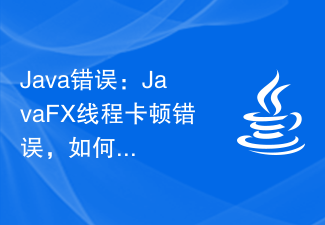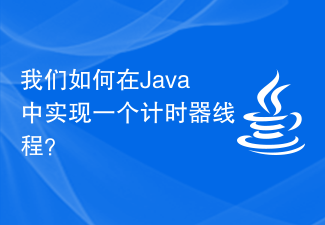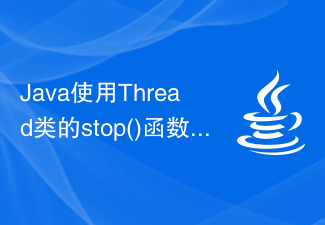In the process of developing JavaFX applications, we often encounter JavaFX thread stuck errors. Such errors vary in severity and may adversely affect program stability and performance. In order to ensure the normal operation of the program, we need to understand the causes and solutions of JavaFX thread stuck errors, and how to prevent this error from occurring.
1. Causes of JavaFX thread stuck errors
JavaFX is a multi-threaded UI application framework that allows programs to perform long-running operations in background threads without affecting to the responsiveness of the user interface. However, if threads are not used correctly in a JavaFX application, thread stuck errors are prone to occur. The main causes of thread stuck errors are as follows:
- Blocking the main thread with long-running operations
In a JavaFX application, the main thread is responsible for processing users Interface refresh and response events. If long-running operations (such as network requests, database reading and writing, etc.) are performed in the main thread, the main thread will be blocked, causing the user interface to become unresponsive.
- Multiple threads operate UI components at the same time
UI components are thread-unsafe objects. If multiple threads operate UI components at the same time, it will easily lead to thread conflicts. and UI component status is abnormal.
- A large number of calculation operations consume CPU resources
If there are a large number of calculation operations in a JavaFX application, and these operations are all running in the main thread, it is easy to consume CPU resources. is exhausted, causing the thread to freeze.
2. How to deal with and avoid JavaFX thread stuck errors
In order to avoid JavaFX thread stuck errors, we need to take some measures, including using thread pools, using Task and Platform.runLater Methods etc.
- Using a thread pool
To avoid performing long-running operations in the main thread, you can use a thread pool to perform these operations. The thread pool can help us manage multiple threads and make the program more stable and efficient by limiting the number of threads and controlling task priority.
- Using Task
JavaFX provides a Task class that can help us perform long-running background tasks without blocking the main thread. In the Task class, we can implement time-consuming operations and return the results to the main thread after the operation is completed.
- Use the Platform.runLater method
If you need to update the status of the UI component in the background thread, you need to use the Platform.runLater method to ensure that the code is executed in the main thread. This can avoid the problem of multiple threads operating UI components at the same time and ensure the stability and performance of the program.
3. Summary
JavaFX thread stuck error is a common development problem, but through appropriate measures and technical methods, we can effectively prevent and solve this error. When developing JavaFX applications, we should pay attention to using correct thread management techniques and avoid multiple threads operating UI components at the same time. This ensures program stability, efficiency and a good user experience.
The above is the detailed content of Java Error: JavaFX thread stuck error, how to deal with and avoid it. For more information, please follow other related articles on the PHP Chinese website!
 8核16线程是什么意思?Feb 02, 2023 am 11:26 AM
8核16线程是什么意思?Feb 02, 2023 am 11:26 AM8核是指CPU有8颗物理核心,16线程是指CPU最多同时可以有16个线程处理任务。核心数和线程数是电脑CPU的重要性能指标,CPU的核心数越高处理速度就越高;线程数越多越有利于同时运行多个程序,因为线程数等同于在某个瞬间CPU能同时并行处理的任务数。多线程可最大限度地实现宽发射、乱序的超标量处理,提高处理器运算部件的利用率,缓和由于数据相关或Cache未命中带来的访问内存延时。
 Java错误:JavaFX线程卡顿错误,如何处理和避免Jun 24, 2023 pm 05:52 PM
Java错误:JavaFX线程卡顿错误,如何处理和避免Jun 24, 2023 pm 05:52 PM在进行JavaFX应用程序开发的过程中,我们常常会遇到JavaFX线程卡顿错误。这种错误的严重程度不同,可能会对程序的稳定性和性能产生不利的影响。为了保证程序的正常运行,我们需要了解JavaFX线程卡顿错误的原因和解决方法,以及如何预防这种错误的发生。一、JavaFX线程卡顿错误的原因JavaFX是一个多线程的UI应用程序框架,它允许程序在后台线程中执行长时
 什么是程序运行时指令流的最小单位Aug 23, 2022 pm 02:16 PM
什么是程序运行时指令流的最小单位Aug 23, 2022 pm 02:16 PM“线程”是程序运行时指令流的最小单位。进程是指一个具有一定独立功能的程序,而线程是进程的一部分,描述指令流执行状态;线程是进程中的指令执行流的最小单位,是CPU调度的基本单位。一个线程是一个任务(一个程序段)的一次执行过程;线程不占有内存空间,它包括在进程的内存空间中。在同一个进程内,多个线程共享进程的资源;一个进程至少有一个线程。
 Go语言中线程和进程的区别解析Apr 03, 2024 pm 01:39 PM
Go语言中线程和进程的区别解析Apr 03, 2024 pm 01:39 PMGo语言中的进程和线程:进程:独立运行的程序实例,拥有自己的资源和地址空间。线程:进程内的执行单元,共享进程资源和地址空间。特点:进程:开销大,隔离性好,独立调度。线程:开销小,共享资源,内部调度。实战案例:进程:隔离长时间运行的任务。线程:并发处理大量数据。
 go语言中协程与线程的区别是什么Feb 02, 2023 pm 06:10 PM
go语言中协程与线程的区别是什么Feb 02, 2023 pm 06:10 PM区别:1、一个线程可以多个协程,一个进程也可以单独拥有多个协程;2、线程是同步机制,而协程则是异步;3、协程能保留上一次调用时的状态,线程不行;4、线程是抢占式,协程是非抢占式的;5、线程是被分割的CPU资源,协程是组织好的代码流程,协程需要线程来承载运行。
 我们如何在Java中实现一个计时器线程?Aug 30, 2023 pm 02:49 PM
我们如何在Java中实现一个计时器线程?Aug 30, 2023 pm 02:49 PMTimer类安排任务在给定时间运行一次或重复。它还可以作为守护线程在后台运行。要将Timer与守护线程关联起来,需要使用一个带有布尔值的构造函数。计时器以固定延迟和固定速率安排任务。在固定延迟下,如果任何一个执行被系统GC延迟,则其他执行也会延迟,并且每次执行都会延迟对应于之前的执行。在固定速率下,如果任何执行被系统GC延迟,则连续发生2-3次执行以覆盖与第一次执行开始时间相对应的固定速率。Timer类提供了cancel()方法来取消计时器。当调用该方法时,定时器终止。Timer类仅执行实现Ti
 Java使用Thread类的stop()函数强制终止线程的执行Jul 26, 2023 am 09:28 AM
Java使用Thread类的stop()函数强制终止线程的执行Jul 26, 2023 am 09:28 AMJava使用Thread类的stop()函数强制终止线程的执行在Java多线程编程中,有时候我们需要强制终止一个正在执行的线程。Java提供了Thread类的stop()函数来实现线程的强制终止。本文将介绍stop()函数的用法,并提供代码示例来说明。在介绍stop()函数之前,我们先了解一下Thread类的几个常用方法:start():启动线程,使线程进入
 Microsoft计划在Windows上的Outlook经典应用程序中引入AI驱动的CopilotOct 19, 2023 pm 11:13 PM
Microsoft计划在Windows上的Outlook经典应用程序中引入AI驱动的CopilotOct 19, 2023 pm 11:13 PMMicrosoft显然不会将其强大的人工智能支持的Copilot工具保留为新应用程序的独家功能。现在,该公司刚刚宣布计划在Windows上的Outlook经典应用程序中引入Copilot。正如其365路线图网站上发布的那样,预览将于明年<>月开始,直到<>月在当前频道的桌面上在全球范围内推出。Copilot是一种生产力工具,它使用大型语言模型(LLM)来帮助用户完成编写电子邮件、汇总文档和翻译语言等任务。它的主要功能之一是它能够总结电子邮件


Hot AI Tools

Undresser.AI Undress
AI-powered app for creating realistic nude photos

AI Clothes Remover
Online AI tool for removing clothes from photos.

Undress AI Tool
Undress images for free

Clothoff.io
AI clothes remover

AI Hentai Generator
Generate AI Hentai for free.

Hot Article

Hot Tools

Dreamweaver Mac version
Visual web development tools

Safe Exam Browser
Safe Exam Browser is a secure browser environment for taking online exams securely. This software turns any computer into a secure workstation. It controls access to any utility and prevents students from using unauthorized resources.

Zend Studio 13.0.1
Powerful PHP integrated development environment

SAP NetWeaver Server Adapter for Eclipse
Integrate Eclipse with SAP NetWeaver application server.

SublimeText3 English version
Recommended: Win version, supports code prompts!






